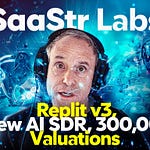How three high-growth companies are actually implementing AI across their revenue operations — and what it means for your AI-informed GTM strategy today.
The AI transformation in go-to-market isn't coming — it's here. But unlike the broad promises we've been hearing, the real story is in the specifics. How are actual revenue leaders at scale implementing AI today? What's working, what isn't, and where should you focus your limited budget?
SaaStr Annual's AI Summit brought together three top GTM leaders who are pushing the envelope on AI implementation across their organizations, together with one a great VC to guide the convo:
Sahana Sarma, Global VP GTM Strategy and Operations at Databricks, brings deep expertise in scaling revenue operations at one of the fastest-growing data and AI companies. She's been instrumental in building Databricks' "Ask Mo" internal agent and driving AI adoption across their field teams.
Rob Schmeltzer, Head of Strategic Customer Success at Monday.com, oversees customer success operations for the work management platform serving over 180,000 customers. He's leading Monday.com's implementation of AI-powered deal desk assistance and automated engagement mapping.
Uri Ouziel, Global Head of Deal Management at Benchling, manages complex deal processes for the life sciences R&D platform. His team has been pioneering automated CSM engagement tracking and customer intelligence aggregation at scale.
Itamar Novick, Founder & General Partner at Recursive Ventures, provides the investor perspective, having backed multiple AI-enabled GTM tools and witnessed the evolution from early promise to practical implementation across his portfolio companies.
What emerged was a practical blueprint for how leaders are really using AI to drive efficiency gains.
The Foundation: Why Point Solutions Aren't Enough
The first major insight that emerged was the limitation of point AI solutions. As Databricks’ Global VP GTM Strategy noted: "I feel like a lot of the point solutions you see in AI are great, but that's where they are. There are point solutions."
The companies seeing the biggest wins are those building on platforms they already have — leveraging Gemini's integration with G Suite or ChatGPT's API capabilities to create customizable, wide-ranging tools rather than adding another vendor to their stack.
The Monday.com Approach: Building Your Deal Desk Co-Pilot
Monday.com's revenue operations team spent two quarters training Gemini to become what they call a "deal desk assistant." Here's how it works:
Deal Intelligence: They feed Gemini their deals, playbooks, and connect it with their CPQ system
Optimization Engine: The AI suggests optimal deal structures and pricing
Efficiency Gains: Significant reduction in clicks and time-to-close for complex deals
The key insight? They didn't buy a new tool. They used an existing, already-adopted platform to solve a specific workflow problem. "When you can do it yourself using an existing tool that is already adopted and already integrated, it's a great win," the Monday.com leader explained.
Customer Intelligence: The New Competitive Advantage
All three companies have made customer research and intelligence a core AI use case, but their approaches vary significantly.
Databricks: The "Ask Mo" Internal Agent
Databricks built their own tool called "Ask Mo" that serves as an entry point into Salesforce, allowing their field teams to:
Research customer organizational changes and triggers
Identify next-best-product opportunities by analyzing similar customer patterns
Generate executive briefing documents by pulling data across their entire stack
Access consistent information quickly as they scale their team
The tool aggregates information across their entire tech stack and serves it to field teams in a conversational interface. This isn't just about efficiency — it's about consistency and quality of customer interactions at scale.
The Research Stack Evolution
Beyond internal tools, field teams are using a combination of:
Gemini and ChatGPT for content creation and analysis
Perplexity for deep customer research
Gong for deal intelligence, pipeline forecasting, and coaching insights
But here's what's interesting: they're not just using these tools individually. The real value comes from synthesizing insights across multiple platforms.
Operations Efficiency: Where AI Shows Immediate ROI
The operations use cases are where AI is delivering immediate, measurable value.
Benchling's Automated Engagement Mapping
Benchling implemented Salesforce's Agent Force to automatically categorize and log CSM engagements. Previously, customer success managers had to manually log every interaction. Now:
Automatic Detection: The system identifies calls, emails, and activities across all systems
Smart Categorization: Engagements are automatically categorized by type
Time Savings: CSMs focus on high-value activities instead of data entry
"Really just an example of trying to take manual repetitive things off of our team's plates," their CS leader explained.
Process Documentation with Scribe
Multiple panelists highlighted Scribe as a game-changer for operations teams. The ability to automatically document processes and turn them into sales enablement courses is "really impactful and saves a bunch of time."
Data Enrichment and Prospecting: The Clay Revolution
Clay emerged as a standout tool across multiple companies, but not for the reasons you might expect. It's not just about data enrichment — it's about building custom workflows.
Clay works because "it is not a point solution but integrates with a bunch of point solutions and enriches data, but you can build it into your own thing." This flexibility allows revenue teams to create custom prospecting and account research workflows without heavy engineering resources.
Touchless Prospecting: The Holy Grail
Multiple companies are running POCs on touchless prospecting — using AI to generate and send prospecting emails without human intervention. But there's a crucial caveat: "You still need to have some kind of human in the loop. We're not yet at the point where things can go out customer-facing without some level of risk and quality control."
Customer Intelligence at Scale: The Interpret Case Study
One of the most sophisticated implementations came from a company using Interpret to analyze customer communications at scale.
The Challenge: They were excellent at understanding individual customer needs but struggled to identify trends across their customer base.
The Solution: Interpret analyzes all customer communications to surface trends around product usage and feature requests, segmented by customer type.
The Impact: This aggregated intelligence has "really helped our conversation that I have and my team has with our product organization." Instead of anecdotal feedback, they now provide data-driven insights to product teams.
The Budget Reality: AI Isn't Free
Here's where the conversation got real. As one panelist put it: "We don't necessarily have more budget. We're already paying for all those tools, and the AI tools are incremental. They want more money, and I don't have a budget."
This budget constraint is forcing companies to make strategic choices:
Build vs. Buy Decision Framework
Leverage Existing Platforms First: Can you solve this with ChatGPT/Gemini integration rather than a new vendor?
Focus on Workflows, Not Features: What specific process are you trying to improve?
Measure Integration Costs: How much effort will it take to get this working with your existing stack?
Enablement and Assessment: The Underrated AI Use Case
Companies are using AI-powered platforms like Udely and Uplimit for sales enablement, but the real value isn't just in content delivery — it's in assessment and impact measurement.
"We are using [these tools] to actually drive enablement and allow us to better assess... how does enablement really impact success?" This data-driven approach to enablement is helping companies optimize their onboarding and ongoing training programs.
The Glean Factor: AI-Powered Knowledge Management
Glean appeared in multiple companies' stacks as a solution for fast-scaling teams. As one leader explained: "We're growing so fast, bringing so many people in. Glean is a pretty effective way for us to get information out to our field that's consistent, especially from a content management perspective."
The key insight: AI-powered search and knowledge management becomes critical as companies scale beyond the point where tribal knowledge works.
What This Means for Your 2025 GTM Strategy
Based on these real implementations, here are the key takeaways for revenue leaders:
Start with Integration, Not Innovation The companies seeing the biggest wins are building on platforms they already have rather than adding new vendors. Before buying a new AI tool, ask: "Can I solve this with our existing ChatGPT or Gemini integration?"
Focus on Process Efficiency First The clearest ROI is coming from automating manual, repetitive tasks. Look for processes where your team is doing data entry, research, or documentation that could be automated.
Customer Intelligence is the New Moat Every company is implementing some form of AI-powered customer research and intelligence. This isn't optional — it's becoming table stakes for competitive sales teams.
Budget for Integration, Not Just Licenses The real cost isn't the AI tool — it's the integration work, training, and ongoing optimization. Budget accordingly.
Human-in-the-Loop is Still Required Despite the hype, no company is comfortable with fully automated customer-facing communications. Plan for human oversight and quality control.
The Road Ahead
The AI transformation in GTM is real, but it's more tactical than transformational right now. Leaders from Databricks to Monday are seeing significant efficiency gains, better customer intelligence, and improved process automation. But they're also being strategic about where they invest and how they implement.
The winners won't be the companies with the most AI tools — they'll be the ones who thoughtfully integrate AI into their existing workflows to solve specific problems. As these implementations mature over the next 12-18 months, the competitive advantages will become even more pronounced.










